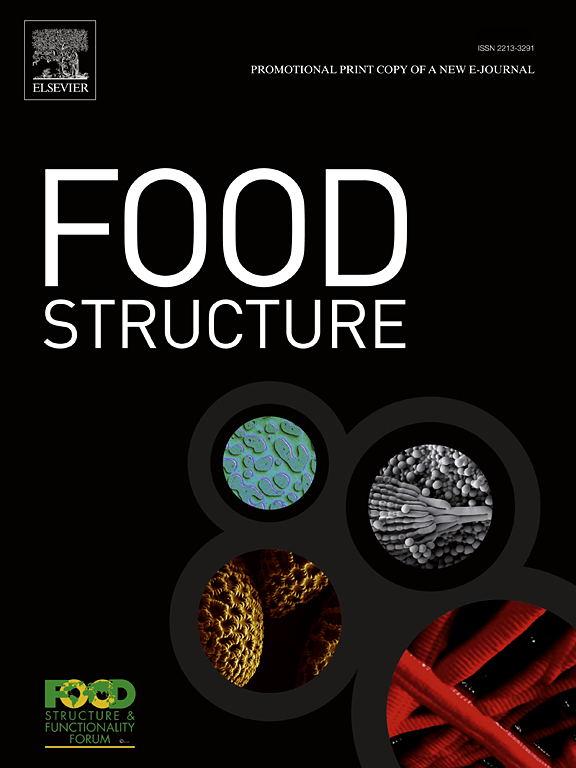Effect of pretreatment methods of Kabuli chickpea on microstructure and physical properties of enriched bread
IF 5.9
3区 农林科学
Q1 FOOD SCIENCE & TECHNOLOGY
引用次数: 0
Abstract
This study examines the impact of chickpea pretreatment methods on the microstructural and physical properties of chickpea-enriched bread, with the goal of determining the most effective treatment for improving bread quality. Five bread formulations were analyzed: a control (100 % wheat flour), a sample with 20 % untreated chickpea flour, and three samples containing 20 % chickpea flour derived from germinated, roasted, or micronized chickpeas. The microstructure of the breads was analyzed using X-ray microcomputed tomography, whereas the physical properties (bread weight, specific volume and crumb colour) were measured according to standard AACC methods. Germination and micronization of chickpeas statistically significantly increased the protein content of the resulting flours (22.1 and 21.5 % dry basis, respectively) as compared to untreated chickpea flour (20.8 % dry basis). The inclusion of pretreated chickpea flours enhanced bread weight and reduced specific volume relative to untreated chickpea-enriched bread and the control sample. Microstructural analysis of breads made with flour from roasted and germinated chickpeas depicted increased open pores, greater uniformity in porosity distribution, thinner crumb walls, and a well-defined, interconnected 3D structure. In conclusion, germination is a promising pretreatment that can be used on chickpeas to enhance the nutritional quality of bread, ensuring physical integrity while enhancing microstructural properties. This study provides valuable insights for optimizing bread production through the incorporation of chickpea flour to develop nutritionally enriched bread.
卡布力鹰嘴豆预处理方法对营养面包微观结构和物理性能的影响
本研究考察了鹰嘴豆预处理方法对鹰嘴豆面包微观结构和物理特性的影响,旨在确定提高面包品质的最有效处理方法。分析了五种面包配方:对照(100 %小麦粉),20 %未经处理的鹰嘴豆粉,以及3种含有20 %鹰嘴豆粉的样品,这些鹰嘴豆粉来自发芽、烘烤或微粉鹰嘴豆。使用x射线微计算机断层扫描分析面包的微观结构,而根据标准AACC方法测量面包的物理性质(面包重量、比容和面包屑颜色)。与未处理的鹰嘴豆粉(20.8 %干基)相比,发芽和微粉化显著提高了所得面粉的蛋白质含量(分别为22.1%和21.5 %)。与未经处理的鹰嘴豆面包和对照样品相比,加入预处理鹰嘴豆面粉增加了面包的重量,降低了比容。用烤鹰嘴豆和发芽鹰嘴豆制成的面包的微观结构分析表明,开放的孔隙增加,孔隙分布更均匀,面包屑壁更薄,并且具有明确的,相互连接的3D结构。综上所述,发芽是一种很有前途的预处理方法,可以用于鹰嘴豆,以提高面包的营养品质,保证面包的物理完整性,同时提高面包的微观结构特性。该研究为通过加入鹰嘴豆粉来开发营养丰富的面包,优化面包生产提供了有价值的见解。
本文章由计算机程序翻译,如有差异,请以英文原文为准。
求助全文
约1分钟内获得全文
求助全文
来源期刊

Food Structure-Netherlands
Chemical Engineering-Bioengineering
CiteScore
7.20
自引率
0.00%
发文量
48
期刊介绍:
Food Structure is the premier international forum devoted to the publication of high-quality original research on food structure. The focus of this journal is on food structure in the context of its relationship with molecular composition, processing and macroscopic properties (e.g., shelf stability, sensory properties, etc.). Manuscripts that only report qualitative findings and micrographs and that lack sound hypothesis-driven, quantitative structure-function research are not accepted. Significance of the research findings for the food science community and/or industry must also be highlighted.
 求助内容:
求助内容: 应助结果提醒方式:
应助结果提醒方式:


